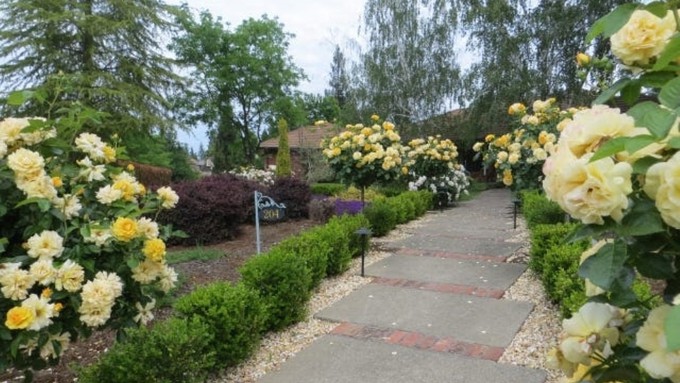
Master rosarian shares tips with Farmer Fred

Julia Child roses line a path in Charlotte Owendyk’s garden. Charlotte Owendyk
When’s the best time to “make” new roses? In the spring, when bushes are growing fast and full of hormones.
Rose propagation via cuttings is easiest in April, May and June, says master rosarian Charlotte Owendyk, who grows hundreds of bushes in her beautiful Roseville garden. Fall is a close second.
That’s just a taste of rosy tips Owendyk offers as this week’s guest on Farmer Fred Hoffman’s podcast, “Garden Basics with Farmer Fred.” During episode 321, the pair discuss spring rose care basics including recognizing diseases and pests. Owendyk notes that hummingbirds love visiting spring rose gardens – they eat aphids! (Other birds like them, too.)
Listen to the podcast here: https://gardenbasics.net/.
Owendyk also shared some of her favorite roses such as ‘Julia Child,’ a yellow floribunda the color of butter. She grows several Julias as tree roses lining the walkway to her front door.
As for propagation, Owendyk has grown many, many new bushes from cuttings, especially miniatures and old varieties not available in nurseries. Don’t get discouraged from a poor success rate; only about half of the cuttings will root in even the best circumstances.
Cuttings are most likely to root if they were attached to a rose that just bloomed. Cut some flowers with longer stems, enjoy them in a vase until the flower is fully open, then use the stem for propagation.
Remember to label your pots! Otherwise, you’ll be left guessing which rose is which. It will be a long time before that little plant will bloom.
Have patience; the rose bushes you see in nurseries are three years old or more.
Farmer Fred shared Owendyk’s instructions in his newsletter:
Charlotte’s Tips for Propagating a Rose Plant
1. Water the rose plant the day before you take cuttings, so the cutting will be fully hydrated.
2. Use a 5-gallon pot and fill it half full with a mixture of 60% peat moss and 40% perlite. (Both retain water and will keep the cutting moist.) Dampen the mixture so it’s moist, but not soggy.
3. Select a healthy plant to take the cuttings. Avoid leaves with diseases and insects! Looking at the plant, pick the best part of the plant. Choose a stem that is vigorous and healthy and is on a healthy and vigorous cane. For softer growers, those with more pith (white inner portion of stem), use older part of cane since this type of stem has a greater possibility of rotting.
4. Select a stem where the rose has just cracked open to just fully open. At this stage, the buds along that stem will produce roots; increasing your success rate. Once the rose is spent, the plant is now telling the buds along the stem to begin producing a new flower.
5. Cut just below the eye (bud, where the leaflet is attached) since this is the most active growing part of the plant.
6. Essentially the cutting only needs two buds – one above the soil and one below. However, many propagators prefer to use a three-node cutting. Remove the bottom leaflet, since this node will be inserted in the growing medium (peat moss and perlite). The remaining one or two leaflets will continue to manufacture food for the cutting.
7. Wash the cutting with 1% bleach (one part bleach to four parts water). Use gloves! Wrap cuttings in a wet paper towel for 24 hours and place in a cooler. Cooler temperatures stimulate the formation of roots.
8. Dip the bottom stem in rooting hormone; use a powder not liquid. (Indolebutyric Acid is the leading plant hormone used to promote the formation of roots in plants and to generate new roots in the cloning of plants through cuttings).
9. Plant at an angle up to the bottom leaf, but make sure that the leaf doesn’t touch the growing medium. Do not crowd the cuttings. (Don’t forget to label your cuttings!)
10. Cover the pot with plastic and punch three or four holes for ventilation.
11. Place the pot in a window on the east side of the house. Check once a week to make sure that the growing medium is damp enough. If you have a heating mat, use it since it accelerates the process.
12. Pull off the plastic in 28 days. Water with diluted liquid fertilizer; acclimate new plants to outdoors.
13. Cut back the little rose plants several times to build up roots. When they look sturdier, transfer to separate pots. This process takes several weeks.
Comments
0 comments have been posted.Sacramento Digs Gardening to your inbox.
Sites We Like
Garden Checklist for week of July 21
Your garden needs you!
* Keep your vegetable garden watered, mulched and weeded. Water before 8 a.m. to reduce the chance of fungal infection and to conserve moisture.
* Feed vegetable plants bone meal, rock phosphate or other fertilizers high in phosphate to stimulate more blooms and fruiting. (But wait until daily high temperatures drop out of the 100s.)
* Don’t let tomatoes wilt or dry out completely. Give tomatoes a deep watering two to three times a week.
* Harvest vegetables promptly to encourage plants to produce more. Squash especially tends to grow rapidly in hot weather. Keep an eye on zucchini.
* Pinch back chrysanthemums for bushy plants and more flowers in September.
* Remove spent flowers from roses, daylilies and other bloomers as they finish flowering.
* Pinch off blooms from basil so the plant will grow more leaves.
* Cut back lavender after flowering to promote a second bloom.
* It's not too late to add a splash of color. Plant petunias, snapdragons, zinnias and marigolds.
* From seed, plant corn, pumpkins, radishes, winter squash and sunflowers.